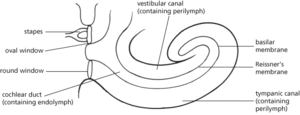Part of the inner ear of mammals, birds, and some reptiles that transforms sound waves into nerve impulses. In mammals it is coiled, resembling a snail shell, and is divided by membranes into three parallel canals (see illustration): the middle cochlear duct (scala media) and two outer canals—the vestibular canal (scala vestibuli) and the tympanic canal (scala tympani)—formed from one long canal folded on itself at a bend at the apex of the cochlea. The small opening at this point, where the vestibular and tympanic canals communicate, is called the helicotrema. The cochlear duct is filled with a fluid (see endolymph) and contains the organ of Corti, which houses the sound receptors. The other two canals also contain a fluid (see perilymph). Sound-induced vibrations of the oval window are transmitted through the perilymph and endolymph and stimulate hair cells in the organ of Corti. These in turn stimulate nerve cells that transmit information, via the auditory nerve, to the brain for interpretation of the sounds.

Diagram of the cochlea (coiling reduced for simplicity)
- Rosicrucian
- Rosicrucianism
- rosin
- Roskilde, Treaty of (1658)
- Rosmini-Serbati, Antonio (1797–1855)
- Rosner test
- Ross, Alf (1899–1979)
- Rossby, Carl-Gustaf Arvid
- Rossby waves
- Rosseland mean opacity
- Rosse, Third Earl of (1800–67)
- Rosse, William Parsons
- Ross, Frank Elmore (1874–1960)
- Rossi, Bruno Benedetti
- Rossi, Bruno Benedetto (1905–93)
- Rossiter effect
- Rossi X-Ray Timing Explorer
- Rossi X-ray Timing Explorer
- Rossi–Forel scale
- Ross, Jerry Lynn (1948– )
- Ross, Sir John (1777–1856)
- Ross, Sir Ronald
- Ross, William David (1877–1971)
- rostral suture
- rostrum